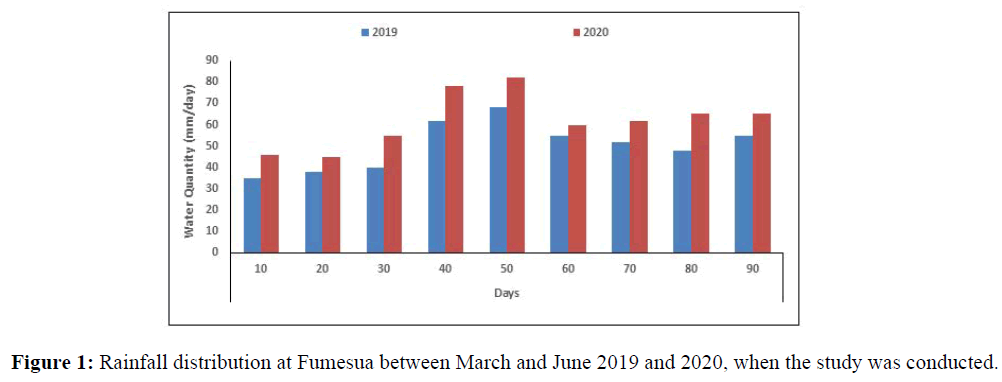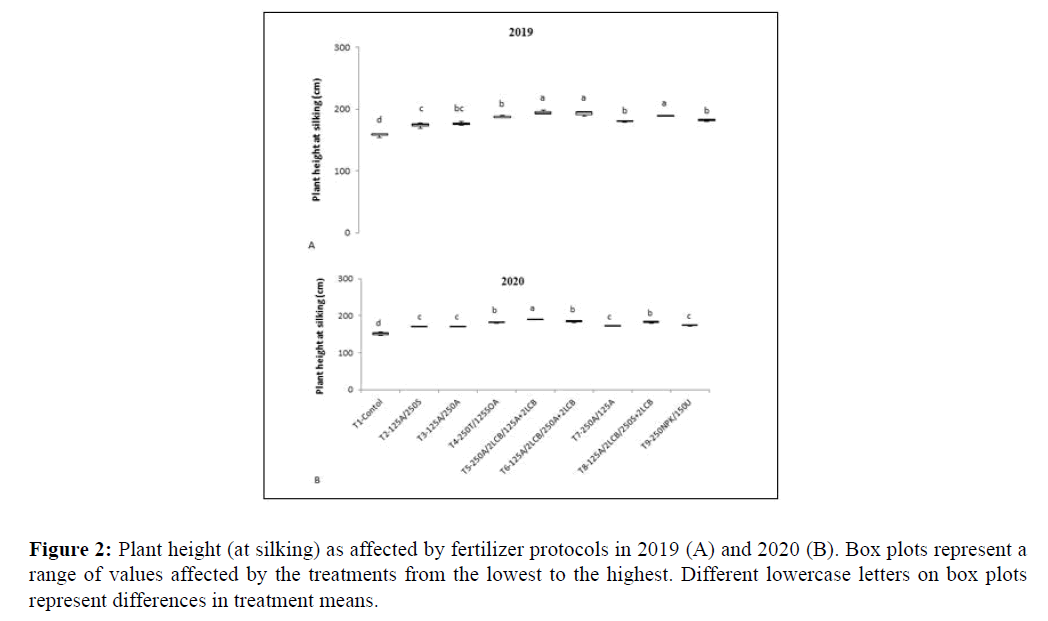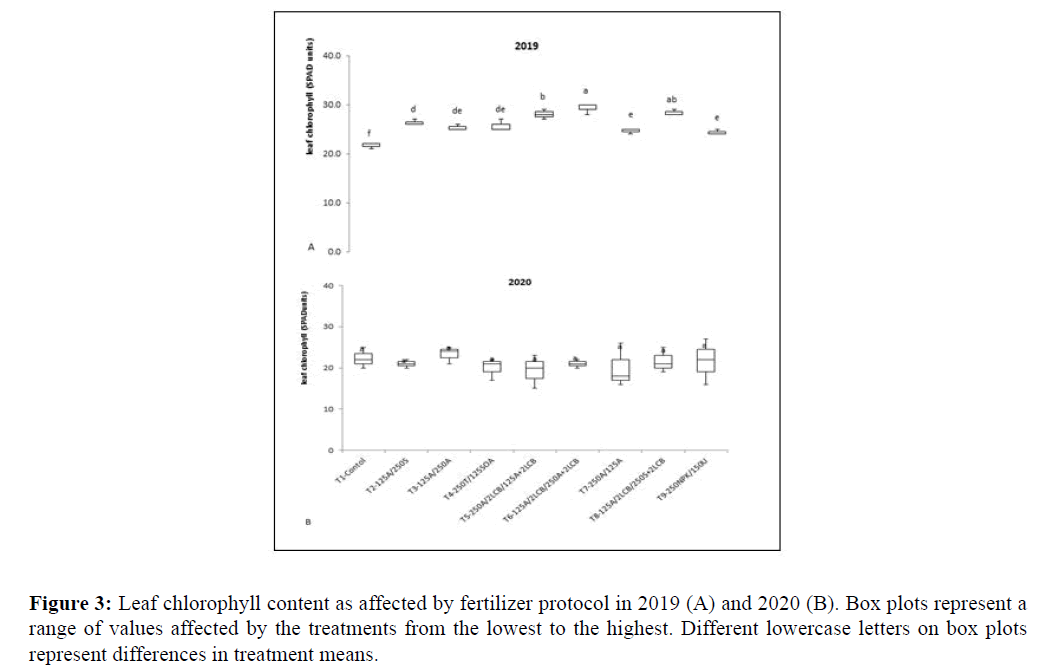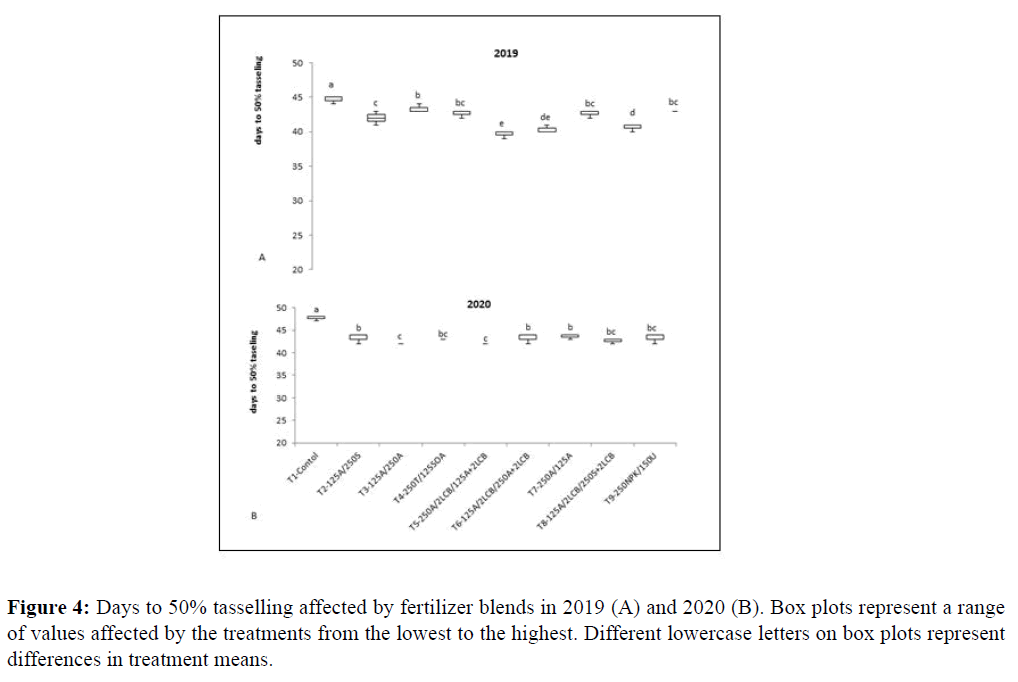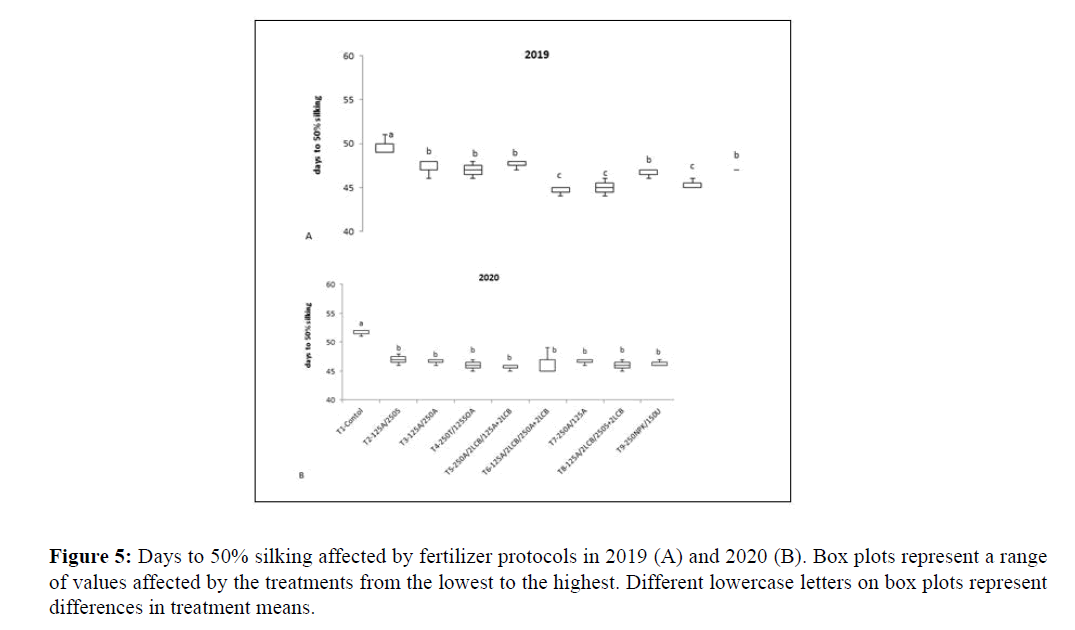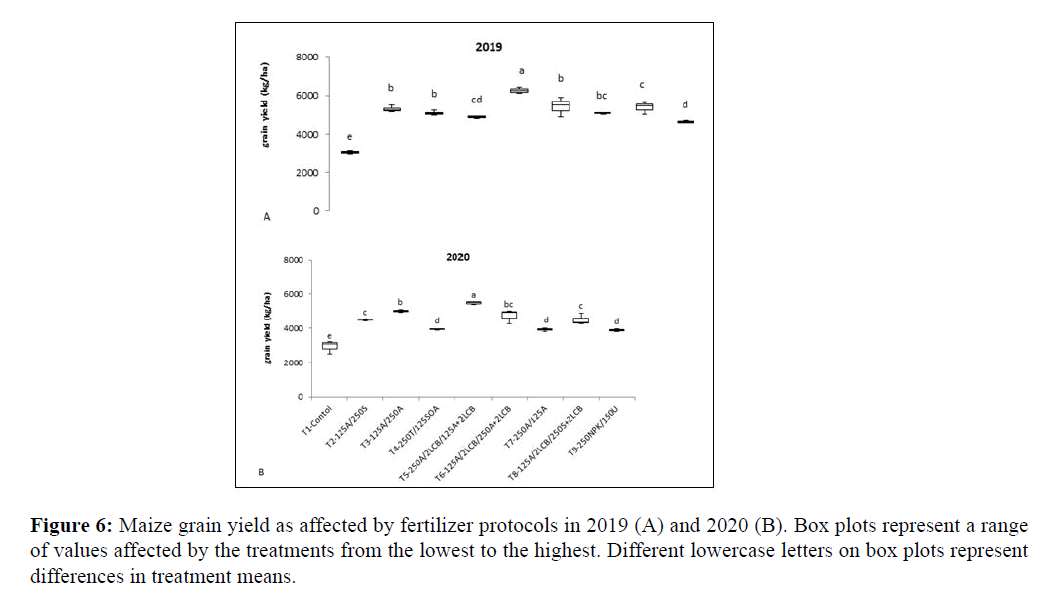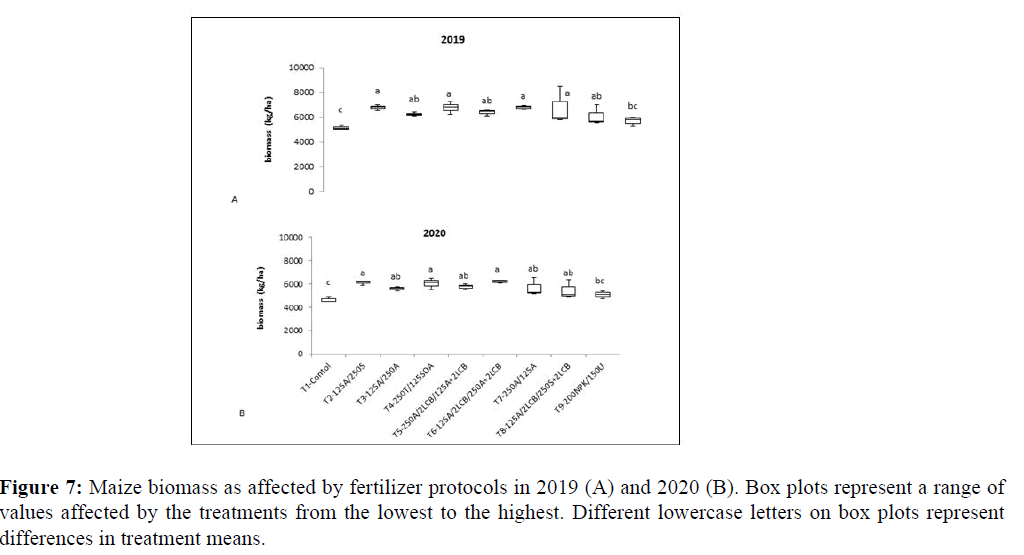ISSN : 2249 - 7412
Asian Journal of Plant Science & Research
Yield Potential of Improved Maize Achieved from Optimal Rates of YARA Crop Nutrition Fertilizers for Sustainable Maize Production in the Semi-deciduous Forest Agro-ecological Zone of Ghana
K Agyeman1*, MB Brempong1, A Ofosu2, Owusu E Danquah1, AK Keteku1, P Marno1, PS Atta Poku3, MO Quaye4 and JN Berchie1
1CSIR-Crops Research Institute, Fumesua-Kumasi, Ghana
2YARA Ghana Limited, Accra, Ghana
3Sunyani Technical University, Sunyani, Ghana
4Department of Agricultural Science Education, University of Education, Winneba, Ghana
- *Corresponding Author:
- K Agyeman
CSIR-Crops Research Institute,
Fumesua-Kumasi,
Ghana,
E-mail: agyemanken@yahoo.com
Received date: August 01, 2023, Manuscript No. AJPSKY-23-17651; Editor assigned date: August 04, 2023, PreQC No. AJPSKY-23-17651 (PQ); Reviewed date: August 18, 2023, QC No. AJPSKY-23-17651; Revised date: August 25, 2023, Manuscript No. AJPSKY-23-17651 (R); Published date: September 01, 2023, DOI: 10.36648/2249-7412.13.8.311
Citation: Agyeman K, Brempong MB, Ofosu A, Danquah OE, Keteku AK, et al. (2023) Yield Potential of Improved Maize Achieved from Optimal Rates of YARA Crop Nutrition Fertilizers for Sustainable Maize Production in the Semi-Deciduous Forest Agro-Ecological Zone of Ghana. Asian J Plant Sci Vol:13 No:8: 311.
Abstract
Wide gaps in maize yield responses to blanket NPK fertilizer application across the agro-ecological zones of Ghana calls for revisions in the recommendation. New fertilizer protocols that focus more on crop nutrition and the supply of many essential nutrients other than just NPK should be tested. This study determined the best YARA crop nutrition fertilizers for optimum maize productivity and economic viability in the semi-deciduous forest agro-ecology of Ghana. Nine treatments consisting of seven different YARA fertilizer protocols, the blanket NPK fertilizer recommendation and a no-amendment control were applied to maize at Fumesua in the Ashanti region of Ghana, in 2019 and 2020. Most of the YARA crop nutrition fertilizers performed better in terms of plant height, leaf chlorophyll concentration and days to 50% tasseling. Days to 50% silking, grain yield and biomass than the blanket NPK recommendation and control in both years. On-field, Treatment 5 (T5) supplied 40 kg/ha N, 16.25 kg/ha P, 31.25 kg/ha K and 6.5 kg/ha S at 2 WAP; half of these rates at 4 WAP and plant growth regulators and doses of some micronutrients at 3 and 4 WAP produced the highest average yield of 5875 kg/ha in the two years compared to 4241 kg/ha from the blanket NPK recommendation. In terms of yield, blanket NPK was only better than the control. T5 and the other four YARA fertilizers were economically viable (Value-to-Cost Ratio>2), while the blanket NPK fertilizer recommendation and two other YARA fertilizers were not (VCR<2). More attention should be given to the adoption of economically viable YARA blends by farmers for improved maize productivity and livelihoods.
Keywords
Fertilizer recommendation; Maize productivity; Value-cost-ratio; YARA fertilizer
Introduction
Maize is a major human staple food crop cultivated in almost all the six agro-ecological zones of Ghana hence improving its productivity is a great feat to achieving food security in the country [1,2]. One major challenge creating wide gaps between farm (1-2 t/ha) and potential yields (6-8 t/ha) of maize varieties released in Ghana is poor soil fertility [3]. Decades ago, a blanket fertilizer recommendation rate (64:38:38 kg/ha N: P2O5:K2O) was developed to improve soil fertility and maize yields [4]. However, this recommendation focused more on macronutrients (NPK) without consideration for essential micronutrients and site-specific differences in agroecological zones [5]. Differences in edaphic and climatic factors of the various agro-ecological zones confer variable results on maize yield with blanket fertilizer recommendations, and this could be a disincentive to farmers. Such variable yield responses (2-10 t/ha) to blanket fertilizer recommendations across the agro-ecological zones of Ghana have been reported by Bua, et al., [5]. Aside from Nitrogen (N), Phosphorus (P) and Potassium (K) which blanket recommendations focus on, the maize plant, which is a heavy nutrient feeder requires an adequate supply of Sulphur (S), Magnesium (Mg), Boron (B), Copper (Cu), Zinc (Zn), Manganese (Mn) and Iron (Fe) for optimum growth and yield [6,7]. The addition of other essential nutrients to blanket recommendations has had better maize yield responses in Ghana and other locations. For example, maize yield increases between 0.8-4.8 t/ha have been recorded by Bua, et al., in Ghana, Khan, et al., in Pakistan and Rasheed, et al., in Pakistan, with the addition of 5-60 kg/ha sulphur to NPK compared to NPK applications alone [5,8,9]. Following blanket fertilizer recommendations alone religiously, leads to devastating mining of other essential nutrients without replacement, and inefficiencies in applied nutrients especially in smallholder farms where continuous maize cropping is common [10]. This calls for revisions in blanket maize fertilizer recommendation rates in Ghana. There is a need to identify new fertilizer crop nutrition programmes, agro-ecological zone specific and economically optimum rates for maize productivity in the country. The poor soil fertility and extremely low maize yield (against the world average) in Ghana suggest a large potential for maize farmers to increase their yields and maximize profit margins with more efficient fertilizer recommendations. Despite government interventions such as the ‘planting for food and jobs’ and fertilizer subsidy policies, to advance the productivity of maize in Ghana, the average yield in the country still ranges between 1.2 to 1.8 tons/ha; one of the lowest in the world [11]. As an initiative to improve yields, ‘YARA Ghana’, a fertilizer company, has recommended new crop nutrition programmes, O for testing on maize. The fertilizers contain doses of N, P, K, S, a balanced combination of essential micronutrients for maize (Zn, B, Mn, Cu and Mo) and/or Ascophyllum nodosum (a rich source of cytokinins, auxins and gibberellins, which are plant growth promoting hormones).
Many smallholder farmers are unable to apply any or all the quantities of required fertilizer due to financial constraints [12]. However, reliable higher economic returns on maize yield may sensitize them to invest in fertilizer. Therefore, the objective of this study was to identify which combinations and rates of the YARA fertilizer (compared to blanket NPK rate) would produce the most economically optimum maize yields for the semi-deciduous forest agro-ecological zone of Ghana. It was hypothesized that at least one of the blends of the YARA fertilizer would produce significantly higher and economically viable maize yield than the decades-long blanket NPK recommendation for improved farmer livelihoods.
Materials and Methods
Description of the study site
The experiments were conducted during the major rainy seasons of 2019 and 2020 at the CSIR-Crops Research Institute (CSIR-CRI) in Fumesua, Ashanti region of Ghana. CSIR-CRI is situated on Latitude 6.7 109°N, Longitude 1.5172°W and 800 m above sea level. It is in the semi-deciduous forest agro-ecological zone (CSIR-CRI weather station). The mean annual rainfall of the area is about 1550 mm. The major rainy season starts from April to the end of July. There is a dry spell in August, while the minor rainy season continues from September to November every year. Annual temperatures range from a minimum of 21.1°C to a maximum of 32.7°C at a mean of 31.6°C.
Land preparation, Experimental design and treatments
The field was ploughed and harrowed to a depth of 15 cm and laid out in randomized complete block design with three replications. There were nine treatments in each replication which made a total of 27 plots. Each plot measured 7.5 m × 4.0 m. The replications were separated by 2 m wide alleys. The treatments included in Table 1.
| T1-Control |
| T2-Actyva 125 kg/ha/Sulfan 250 kg/ha |
| T3-Actyva 125 kg/ha/Actyva 250 kg/ha |
| T4-T15 @250 kg/ha/SOA @125 kg/ha |
| T5-Actyva 250 kg/ha/Croplift Bio 2 L/ha/Actyva 125 kg/ha+Croplift Bio 2 L/ha |
| T6-Actyva 125 kg/ha/Croplift Bio 2 L/ha/Actyva 250 kg/ha+Croplift Bio 2 L/ha |
| T7-Actyva 250 kg/ha/Actyva 125 kg/ha |
| T8-Actyva 125 kg/ha/Croplift Bio 2 L/ha/Sulfan 250 kg/ha+Croplift Bio 2 L/ha |
| T9-NPK 15-20-20 @200 kg/ha/Urea @ 150 kg/ha |
| Note: Aside, T1 and T8, all treatments were YARA fertilizer formulations. |
Table 1: Fertilizer types, rates and time of application.
Initial soil sampling and analysis
Before treatment allocation, the soil was sampled from the prepared field using an auger at two depths, 0-15 cm and 15-30 cm. The samples were air-dried, ground and passed through a 2 mm sieve to remove stones and debris. The soil samples were analyzed at the CSIR-Soil Research Institute, Kwadaso-Kumasi to determine its chemical and physical characteristics. Chemical parameters measured were soil pH, percent organic matter, total nitrogen, exchangeable bases (K, Ca, Mg and Na), Effective Cation Exchange Capacity (ECEC), percentage base saturation and available phosphorus. Soil physical properties measured were the texture (sand, clay and silt percentages) which are stated in Table 1.
Precipitation trend
The total rainfall recorded during the growth period of the crop increased from 453 mm in 2019 to 558 mm in 2020 (Figure 1). The 2019 crop experienced intermittent dry spell especially during the reproductive growth stages. The area experienced a mean minimum temperatures of 21°C and 31°C respectively.
Seed sowing
In both years, the early maturing maize variety, “Abontem” developed and released by CSIR-CRI was used as a test crop for the study. The seeds had a 98% germination percentage. They were surface treated against soil-borne pathogens and arthropods before planting. They were planted by dibbling three seeds per hill (5 cm) at a recommended spacing of 75 cm × 30 cm and a plant population of 66,666 plants/ha. Thinning was done 10 Days After Sowing (DAS) to two plants per hill.
Weed control
Two hand weeding exercises were carried out at 14 and 35 DAS, and one weedicide (glyphosate-480 g/L) spray was applied 1 DAS, for weed control in both years. Fall armyworm infestation was managed following protocols prescribed by the CSIR-CRI and the Ministry of Food and Agriculture (MoFA).
Fertilizer application
YARA fertilizers (as described in the treatment section) were used in this study. Granular-based fertilizers (Actyva, Sulfan, T15 and NPK) of each were split and applied at the specified rates (treatment section) at 2, 3 and 4 Weeks After Planting (WAP), when the soil was adequately moist. Quantities to be applied were weighed using electronic scales and applied by the band placement method at 5 cm depth and 5 cm away from maize root. Timelines for fertilizer application are as follows:
• T2 was applied as 125 kg/ha Actyva at 2 WAP and 250 kg/ha Sulfan at 3 WAP.
• T3 was applied as 125 kg/ha Actyva at 2 WAP and 250 kg/ha Actyva at 3 WAP.
• T4 was applied as 250 kg/ha T15 at 2 WAP and 125 kg/ha Sulphate of Ammonuim at 3 WAP.
• T5 was applied as 250 kg/ha Actyva at 2 WAP and 2 L/ha of Croplift Bio, 3 WAP and 125 kg/ha Actyva with 2 L/ha Croplift Bio at 4 WAP.
• T6 was applied as 125 kg/ha Actyva at 2 WAP, 2 L/ha Croplift Bio at 3 WAP and 250 kg/ha Actyva with 2 L/ha Croplift Bio at 4 WAP.
• T7 was applied as 250 kg/ha Actyva at 2 WAP and 125 kg/ha Actyva at 3 WAP.
• T8 was applied as 125 kg/ha Actyva at 2 WAP, 2 L/ha Croplift Bio at 3 WAP and 250 kg/ha Sulfan with 2 L/ha Croplift Bio at 4 WAP.
• T9 was applied as 200 kg/ha NPK 15-15-15 at 2 WAP and 150 kg/ha Urea at 3 WAP.
Plant sampling and growth data
Six representative plants were randomly sampled from each net plot and tagged for periodic data measurement. (The net plots excluded the borders). Parameters measured were: Plant height at silking, days to 50% tasseling, days to 50% silking, days to maturity, leaf chlorophyll content at silking, and above-ground biomass after harvest. All measurements started at 30 DAS at an interval of 15 days. Plant heights were measured from the plant base to the shoot apex tip. The chlorophyll meter, SPAD-502 (Minolta Camera Co., Ramsey, NJ) was used for the measurement of leaf greenness (chlorophyll concentration) at 10 days intervals.
Yield and grain nutrient data
Harvesting was done at physiological maturity (90 DAS) from the net plot on a treatment basis. The total number of cobs plant-1, cob yield plant-1, and grain yield cob-1 were recorded from the sample plants. The harvested cobs from the entire net plot were sun-dried and threshed with a mechanical thresher. The seeds were dried to 12% moisture content (measurement was done by the moisture meter). A hundred seeds were randomly counted from each replication for test weight measurement. Grain yield plant-1 was calculated with the formula below and converted into kg/ha.

Note: Where 0.8 is the shelling % and the denominator ‘85’ converts the equation to 15% MC.
Statistical data analysis
The data is visualized with boxplots representing the minimum, first quartile, median, third quartile and maximum values of each parameter affected by treatment. Parameters measured from plants in each year were subjected to fisher’s method of one-way Analysis of Variance (ANOVA) using the IBM SPSS Statistics 20. Wherever the F-value was significant, the Least Significant Difference (LSD) was used to separate the treatment means at 5% probability [13].
Value-to-Cost Ratio (VCR)
Value-Cost Ratios (VCR) were used to determine the economic viability of the applied treatments. They were calculated by determining the net benefits of treatment:

The adjusted maize yield was calculated as follows:
Adjusted maize yield=Average maize yield from treatment in two years-average maize yield from the control.
The wholesale price of maize in the experiment location (Kumasi) in 2020 was obtained from www.esoko.com/foodproces- in-ghana-march-2020/. A 50 kg bag of maize cost about 105 Ghȼ at wholesale outlets in 2020. Prices of the YARA fertilizer blends, NPK and Urea in 2020 were used in the calculations. Actyva was 180 Ghȼ, sulfan was 115 Ghȼ, T15 was 140 Ghȼ, urea was 136 Ghȼ, Croplift Bio was 35 Ghȼ per litre, sulphate of ammonium was 200 Ghȼ and NPK was 280 Ghȼ per 50 kg bag.
Results
Initial soil analysis
Soil pH ranged between 6.69-6.88 at 0-30 cm soil depth. Nitrogen (N) concentration ranged from 0.08% to 0.11%; Phosphorus (P) ranged from 8.3-9.6 cmol/kg; Potassium (K) ranged from 0.22-0.25 cmol/kg; Magnesium (Mg) ranged from 1.7-2.13 cmol/kg; Calcium (Ca) ranged from 3.05-3.26 cmol/kg at 0-30 cm soil depth. Soil Organic Matter (OM) content ranged from 1.75% to 2.08%. (Table 2).
| Chemical properties | Physical properties | ||||||||||
|---|---|---|---|---|---|---|---|---|---|---|---|
| Depth | pH | P | K | Mg | Ca | N | O-C | OM | Sand | Clay | Silt |
| cmol (+)/kg | % | ||||||||||
| 0-15 | 6.69 | 9.6 | 0.25 | 2.13 | 3.26 | 0.11 | 0.82 | 2.08 | 86 | 6 | 8 |
| 15-30 | 6.88 | 8.3 | 0.22 | 1.7 | 3.05 | 0.08 | 0.62 | 1.75 | 84 | 3 | 13 |
Table 2: The soil had 86% sand, 6% silt and 8% clay at the topsoil (0-15 cm depth).
Maize growth response to fertilizer treatments
In 2019, T5 influenced the tallest plants (194 cm) which were comparable (p>0.05) to T6 and T8 but were on average 6% higher (p<0.01) than the blanket NPK rate and 19% higher than the control (Figure 2A), whereas in 2020, plants applied with T5 were the tallest (p<0.01) but comparable to all other treatments except the control and T7 (Figure 2B). Plants applied with T5 were 9% taller than plants applied with T7 and 20% taller than the control.
In 2019, plants applied with T5, T6 and T8 had the highest leaf chlorophyll concentrations (28-29 SPAD units) which were between 10% to 25% more (p<0.01) than the other YARA protocols, the blanket NPK rate and the control in 2019 (Figure 3A). However, in 2020, leaf chlorophyll concentrations at the time of measurement was comparable (p=0.89) for all nine treatments (Figure 3B).
In both 2019 and 2020, plants applied with T5 were the earliest (p<0.01) to tassel and silk. About half the number of plants applied with T5 took approximately 40 days to tassel in 2019 compared with 44 days for the control and 43 days for the blanket NPK rate (Figure 4A). This year, 50% of plants applied with T5 and T6 silked for around 45 days, similar to the other YARA blends, but took 47 and 49 days to silk with the control and the NPK blanket rate (Figure 5A). In 2020, 50% of plants applied with all the YARA crop nutrition programme and NPK blanket rate took between 42-43 days to tassel while the control took 47 days (Figure 4B). While all other treatments took approximately 46 days to silk, the control took almost 52 days in 2020 (Figure 5B).
Maize yield response to fertilizer treatments
Treatment 5 recorded the highest (p<0.01) maize grain yield in 2019 and 2020 (Figures 6A and 6B). In 2019, it resulted in an average yield of 6261 kg/ha maize while yields from the other YARA blends ranged from 4853-5416 kg/ha of maize grains. The blanket NPK fertilizer recorded 4613 kg/ha maize yield which was 5%-26% lower than yields recorded by any of the YARA fertilizer protocols. The control recorded the least maize yield of 3026 kg/ha. In 2020, T5 had an average yield of 5488 kg/ha of maize grains compared with the 3922-5005 kg/ha from the other YARA fertilizer blends. The blanket NPK fertilizer recorded 3870 kg/ha which was 1%-29% below yields from any of the YARA protocols. The control affected the least yield of 2935 kg/ha maize.
Figure 6: Maize grain yield as affected by fertilizer protocols in 2019 (A) and 2020 (B). Box plots represent a range of values affected by the treatments from the lowest to the highest. Different lowercase letters on box plots represent differences in treatment means.
Maize biomass was comparable for all the YARA fertilizer blends and the NPK blanket fertilizer in 2019 (Figure 7A) and ranged from 5687 to 6795 kg/ha with these treatments. However, they were significantly higher (p=0.04) than the biomass recorded by the control (5116 kg/ha). A similar trend occurred in 2020 (Figure 7B).
The economic viability of treatments
Economic viability analysis for the applied treatments is presented in Table 2. VCR values ranged from 3.9 to 1.6 in the order (T2>T3>T8>T7>T5> (T4=T9)>36. Treatments 3, 4, 5 and 8 had VCR above 2 (Table 3).
| Treatment | T2 | T3 | T4 | T5 | T6 | T7 | T8 | T9 |
|---|---|---|---|---|---|---|---|---|
| Mean maize yield (kg/ha) | 4882 | 5037 | 4394 | 5875 | 5081 | 4495 | 4928 | 4241 |
| Adjusted yield (kg/ha) | 1901 | 2057 | 1413 | 2895 | 2100 | 1515 | 1948 | 1261 |
| Wholesale price (Ghȼ/ha) | 3993 | 4320 | 2968 | 6079 | 4411 | 3181 | 4091 | 2648 |
| Cost of Actyva | 450 | 1350 | x | 1350 | 1350 | 1350 | 450 | x |
| Cost of Croplift Bio (Ghȼ/ha) | x | x | x | 140 | 140 | x | 140 | x |
| Cost of T15 (Ghȼ/ha) | x | x | x | x | X | x | x | x |
| Cost of sulfan (Ghȼ/ha) | 575 | x | 700 | x | X | x | 575 | x |
| Cost of sulphate of ammonia (Ghȼ/ha) | x | x | 500 | x | X | x | x | x |
| Cost of NPK 15:15:15 (Ghȼ/ha) | x | x | x | x | X | x | x | 1120 |
| Cost of urea (Ghȼ/ha) | x | x | x | x | X | x | x | 408 |
| Total fertilizer cost (Ghȼ/ha) | 1025 | 1350 | 1200 | 2790 | 2790 | 1350 | 1165 | 1528 |
| Net benefits (Ghȼ/ha) | 2968 | 2970 | 1768 | 3289 | 1621 | 1831 | 2926 | 1120 |
| VCR | 3.9 | 3.2 | 1.7 | 2.2 | 1.6 | 2.4 | 3.5 | 1.7 |
Table 3: Net benefits and value cost ratio of the applied treatments.
Discussion
The initial soil chemical and physical analyses indicated that the soil pH was almost neutral (6.69 to 6.88) and ideal for maize growth [14]. Soil organic matter content was below the productive value of 4% [15]. Soil nitrogen (0.08%-0.11%) and other nutrients were inherently low, hence application of fertilizer should have a strong positive influence on maize, provided the soil was responsive and this was confirmed by the positive responses in maize parameters recorded. Particle size distribution indicates that the soil texture was Loamy sand [16].
The YARA fertilizer protocols used in this study have extra constituents than the normal blanket NPK fertilizer recommendation. Actyva contains 23% N, 10% P, 5% K and 3% S. Sulfan contains 24% N and 6% SO3. Croplift Bio contains balanced combinations of 8.5% N, 3.4% P, 6% K, 0.11% Mn, 0.1% Cu and 0.003% Mo with Ascophyllum nodosum (a rich source of cytokinins, auxins and gibberellins). T15 contains NPK 15-15-15 with balanced quantities of ammonium and nitrate–N forms compared to normal NPK 15-15-15 (www.yara.co.uk/cropnutrition/ fertiliser/). Aside from N, P and K which are common to the blanket NPK fertilizer rate, all the other nutrients and plant growth regulators the YARA protocols contain are extra benefits to maize growth and yield. They are therefore responsible for the improvements in maize productivity observed from the YARA fertilizer protocols in this study.
Treatment Five (T5) which affected almost all the highest growth (plant height, chlorophyll content, days to 50% tasseling, days to 50% flowering) and yield (grain yield, biomass) parameters was an application of 250 kg/ha Actyva at 2 WAP, Croplift Bio at 3 WAP and a mixture of 125 kg/ha Actyva and 2 L Croplift Bio at 4 WAP. Thus the plants received 40 kg/ha N, 16.25 kg/ha P, 31.25 kg/ha K and 6.5 kg/ha S at 2 WAP; and received half of these rates at 4 WAP. They also received plant growth regulators and some doses of micronutrients at 3 and 4 WAP. The early application (2 WAP) of relatively large rates of N, P, K and S (250 kg/ha Actyva at 2 WAP compared to 125 kg/ha Actyva at 4 WAP) promoted early active nutrient flow to plant roots, early vegetative growth and enough time to accumulate large assimilate which later translocated into yield. Our result is in line with the findings of Namo, et al., and Agyeman, et al., [17,18], which reported of fast growth rate, early tasseling and silking and higher grain yield from the application of NPK, 2 WAP compared to applications at 4 and 6 WAP. The inability of T6 (same treatment sequence but quantities of Actyva interchanged at 2 and 4 WAP) to affect the highest yield, though it was comparable to T5 in terms of growth parameters could be due to the differences in Actyva quantities at 2 WAP. A relatively higher Actyva fertilizer rate applied at 2 WAP with T5 made more nutrients available to improve growth and yield. Similar to our finding, relatively higher N supplied through the highest Actyva rate at 2 WAP through T5 (compared to lower Actyva rates at 2 WAP from T6) resulted in the highest growth and yield in a study reported by Agyeman, et al., [19]. It also suggests that the maize growth stage at 2 WAP is a critical nutrient-dependent stage as reported by Amali and Namo and Timon, et al., and the amount applied at this stage is of great importance [20]. Though T9 (the recommended blanket NPK rate) supplied a total of 99 kg/ha N, while T5 supplied about 60 kg/ha N, the supply of S, plant growth regulators and essential micronutrients in T5 accounted for increased growth and higher yield with the T5. It is observed from the study that all YARA protocols almost always performed better than the blanket NPK recommendation because of their extra constituents. Maize yield increases between 0.8-4.8 t/ha have been recorded by Bua, et al., [5] and Agyeman, et al., [21] in Ghana, Khan, et al., [8] in Pakistan and Rasheed, et al., [9] in Pakistan, with the addition of 5-60 kg/ha sulphur to NPK compared to NPK applications alone. In this study, T5 supplied about 9.5 kg/ha S, which falls within the optimum range. Kumar, et al., [22] found in a review, that the application of blanket NPK with 50 kg/ha S and 10 kg/ha Zn maximized maize yield, nutrient concentrations and monetary returns to growers. Sulfur is increasingly being recognized as the 4th most important macronutrient after NPK and it is responsible for chlorophyll formation and protein synthesis [23] which plays major roles in maize grain filling. However, the excessive supply of S with the addition of 250 kg/ha sulfan to 125 kg/ha Actyva (T2) which supplied a total of 90.7 kg/ha S may have caused the yield declining S toxicities, leading to the observed inability of T2 to compare with T5. An amount of 60 kg/ha, S has been reported as the cut-off beyond which elevated tissue sulfate concentrations induce yield declines [5,8,23]. Moreover, the application of Croplift Bio in T5 added micronutrients and Ascophyllum nodosum which added plant growth regulators. Micronutrients promote plant physiological processes such as protein synthesis, chlorophyll formation, photosynthesis, seed formation and starch translocation [24] among others which determine maize growth and yield. Our results confirm the findings of who determined that in the presence of Zn and Mn (micronutrients) Ascophyllum nodosum extracts (a rich source of plant growth regulators) promote maize growth and yield. Auxins promote plant cell growth and elongation; cytokinins increase chlorophyll synthesis, reduce sugar accumulation and prolong photosynthesis in senescing plant leaves; while gibberellins promote seed germination, root and shoot elongation, flowering and fruit patterning [25]. These chemicals regulated plant growth and yield formation, resulting in the observed findings in this study. Our results confirm the reports of Llanes, et al., [26] who found that formulations of plant growth hormones together with fertilizer improved maize shoot growth and dry matter accumulation and delayed leaf senescence compared to fertilizer alone. Many research findings have suggested a revision of blanket NPK recommendations because, in recent years, site-specific recommendations and consideration for other nutrients together with NPK are more effective [5,8,23,27]. Since maize grain yield is the most economic part of the plant, fertilizer protocols and combinations should be focused on improving yield. Most of the YARA fertilizer protocols influenced better yields than the blanket NPK recommendation; hence the findings of this study support the need for revisions in blanket NPK fertilizer rates.
Value-to-cost ratio analyses of the treatments suggest that treatments 2,3,5,7 and 8 were the most economically viable options. They all had a VCR>2, which implies they gave better monetary value for the cost incurred than T4, 6 and 9 (the blanket NPK recommendation) which recorded VCRs below 2. A VCR of 2 or more implies economic viability; and the higher the value the more economical than treatment was [28,29]. The lower VCR from T6 (1.6) compared to T5 (2.2) strongly suggests that the amounts of fertilizer applied at every stage in a sequence of split fertilizer application are critical to yield. Though they both contained the same fertilizer blends at the same cost, interchanging quantities of Actyva at 2 and 4 WAP resulted in wide yield and economic viability gaps. On face value, T5 had the highest yield and net profit, but T2, with a VCR of 3.9, gave the best value for money invested in fertilizer, all other things being equal. Financially challenged farmers may adopt T2 for appreciable returns on investment. However, depending on the financial capabilities of a farmer to invest in fertilizer, any of the economically viable treatments 2, 3, 5, 7 and 8 could be adopted.
Conclusion
The 250 kg/ha Actyva at 2 WAP, 2 L Croplift Bio at 3 WAP and a mixture of 125 kg/ha Actyva and 2 L Croplift Bio at 4 WAP was the best YARA fertilizer blend for optimum maize growth and yield in the Semi-deciduous agroecological zone of Ghana. It influenced 6261 kg/ha maize yield which was 26% above the maize yield affected by the blanket NPK fertilizer rate in 2019. In 2020, it influenced maize yield of 5488 kg/ha, 29% above the maize yield of the blanket NPK rate. Most of the remaining YARA protocols still performed better than the blanket NPK recommendation. Treatments 2, 3, 4, 5, 7 and 8 were the most economically viable options while T4, T6 and T9 (blanket NPK recommendation) were not economically viable. Among the economically viable treatments, T2 (125 kg/ha Actyva at 2 WAP and 250 kg/ha Sulfan at 3 WAP) gave the best value for every cedi of fertilizer cost applied. Hence financially constrained farmers may adopt it for appreciable returns. Also, depending on the financial capabilities of farmers, any of the economically viable YARA protocols could be adopted. Our findings support the call for more site-specific fertilizer recommendations and the inclusion of other essential nutrients necessary for crop growth and yield.
Acknowledgement
The authors of this study wish to acknowledge YARA Ghana Limited for providing funding for this study. The authors also wish to extend their appreciation to the Director and staff of CSIR-Crops Research Station, Kumasi- Ghana for providing facilities for this study.
Conflict of Interest
The authors declare that there is no conflict of interest.
References
- Wongnaa CA, Awunyo-Vitor D, Mensah A, Adams F (2019) Profit efficiency among farmers and implications for poverty alleviation and food security in Ghana. Sci Afr 6: e00206.
[Crossref], [Google Scholar]
- MoFA (Ministry of Food and Agriculture) (2012) Ghana maize strategy document and investment opportunities for the private sector. Statstics Research and Information Directorate (SRID), Accra, Ghana.
- Danquah OE, Beletse Y, Stirzaker R, Smith C, Yeboah S, et al. (2020) Monitoring and modeling analysis of maize (Zea mays L.) yield gap in smallholder farming in Ghana. Agriculture 10: 420.
[Crossref], [Google Scholar]
- Agricultural extension handbook (1997) Ghanaian-German Agric. Development Project, Northern and Upper Regions, Tamale, 41.
- Bua S, Mejahed EIK, MacCarthy D, Adogoba DS, Kissiedu IN, et al. (2020) Yield responses of maize to fertilizers in Ghana. IFDC FERRARI Research Report No 2.
- Sapkota D, Pokhrel S (2010) Community based maize seed production in the hills and mountains of Nepal: A review. Agron J Nepal 1: 107-112.
- (2008) Forage maize-fertilizer requirements. Potash Development Association.
- Khan MJ, Khan MH, Khattak RA, Jan MT (2006) Response of maize to different levels of sulfur. Comm Soil Sci and Plant Anal 37: 41-51.
[Crossref], [Google Scholar]
- Rasheed M, Ali H, Mahmood T (2004) Impact of nitrogen and sulfur application on growth and yield of maize (Zea mays L). Crop J Res Sci 15: 153-157.
- Naab JB, Mahama GY, Yahaya I, Prasad PVV (2017) Conservation agriculture improves soil quality, crop yield and incomes of smallholder farmers in North Western Ghana. Front Plant Sci 8: 996.
[Crossref], [Google Scholar], [Indexed]
- International Food Policy Research Institute (IFPRI) (2015) Statistics on Public Expenditures for Economic Development (SPEED).
[Crossref]
- Tetteh FM, Isaka RN, Ennin S, Buri MM (2008) Soil fertility initiative, fertilizer update and recommendation trials. Soil Research Institute of Ghana 33. [Crossref], [Google Scholar], [Indexed]
- Panse VG, Sukhatme PV (1985) Statistical methods for Agricultural workers. ICAR: 87-89.
- NSW Agriculture (2000) Understanding soil pH.
- Hatten J, Liles G (2019) Chapter 15-A ‘healthy’ balance-The role of physical and chemical properties in maintaining forest soil function in a changing world. Adv soil sci 36: 373-396.
[Crossref], [Google Scholar]
- Asei R, Abaidoo RC, Opoku A, Adjei-Nsiah S, Antwi-Agyei P (2021) Use of limiting nutrients for reclamation of non-responsive soils in Northern Ghana. Front Soil Sci 1: 1-10.
[Crossref], [Google Scholar]
- Amali PE, Namo OAT (2014) Effect of time of fertilizer application on growth and yield of maize (Zea mays L.) in Jos-plateau environment. Global J Agric Sci 14:1-9.
- Agyeman K, Afuakwa JJ, Dankwa EO, Asubonteng KO (2012) Improving soil fertility for maize (Zea mays L.) production using inorganic and organic fertilizer: A case of N: P: K 15: 15: 15 and biomass of agroforestry trees. South Asian J Exp Biol 2: 5-11.
- Agyeman K, Berchie JN, Asumadu H, Yeboah S, Acheampong P, et al. (2013) An evaluation of the effects of YARA fertilizers on the growth and yield performance of maize (Zea mays L.) and its economic implications to farmers in Ghana. Int J Sci Adv Tech 3: 1-12.
- Timon D, Zakawa NN, Yusuf CS (2020) Effect of fertilizer application periods on the growth and yield of two hybrid maize (Zea mays L.) varieties in Mubi, Adamawa State, Nigeria. Int J Agric Env Biores 5: 234-243.
[Crossref]
- Agyeman K, Osei-Bonsu I, Berchie JN, Yeboah S, Tengan LM, et al. (2020) Yield and growth performance of drought tolerant maize varieties in the forest savanna transition zone of Ghana. Agric Food Sci 13: 1238-1247.
- Kumar R, Kumawat N, Kumar S, Singh AK, Bohra JS (2017) Effect of NPKS and Zn fertilization on growth, yield and quality of baby corn-a review. Int J Curr Microbiol App Sci 6: 1392-1428.
[Crossref], [Google Scholar]
- Sutar RK, Pujar AM, Kumar BNA, Hebsur NS (2017) Sulphur nutrition in maize- A critical review. Int J Pure app Biosci 5: 1582-1596.
[Crossref], [Google Scholar]
- Tanwar K, Rathi N, Dagar H, Malik K, Sharma R, et al. (2019) Role of micronutrients in maize production under Haryana ecological conditions. Advances in Agriculture and Biodiversity 5: 177-179.
- Mundiyara R, Sodani R, Bhati SS (2020) Role of plant growth regulators in crop production. Agric and Food: E-newsletter.
- Llanes A, Iparraguirre J, Masciarelli O, Maria, N, Luna V (2018) Foliar application of phytohormones enhances growth of maize and soybean seedlings. Articulos 45: 61-66.
- Mutegi J, Kabambe V, Zingore S, Harawa R, Wairegi L (2015) The status of fertilizer recommendation in Malawi: Gaps, challenges and opportunities.
- Morris M, Kelly VA, Kopicki RJ, Byelee D (2007) Fertilizer use in African agriculture: Lessons learned and good practice guidelines. The World Bank 162.
[Crossref], [Google Scholar]
- Metson AJ (1961) Methods of chemical analysis for soil survey samples. Agronomy 12: 208.
[Crossref]

Open Access Journals
- Aquaculture & Veterinary Science
- Chemistry & Chemical Sciences
- Clinical Sciences
- Engineering
- General Science
- Genetics & Molecular Biology
- Health Care & Nursing
- Immunology & Microbiology
- Materials Science
- Mathematics & Physics
- Medical Sciences
- Neurology & Psychiatry
- Oncology & Cancer Science
- Pharmaceutical Sciences
